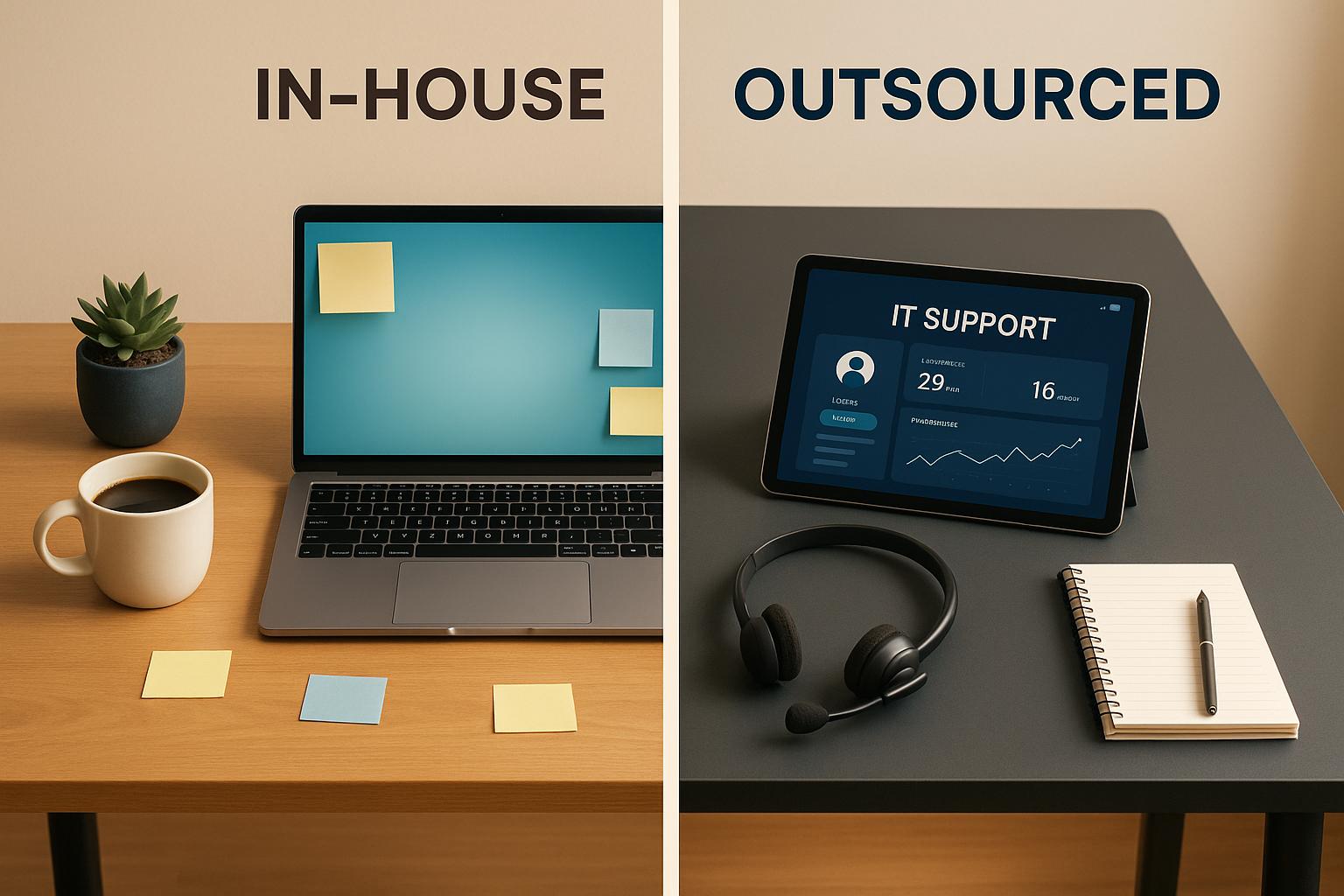Deciding between in-house and outsourced IT depends on your business’s priorities. Here’s a quick breakdown:
- In-House IT: Offers direct control, deep system knowledge, and real-time decision-making. However, it comes with high costs (salaries, benefits, infrastructure) and challenges in scaling or hiring specialized talent.
- Outsourced IT: Provides access to specialized expertise, predictable costs, and scalability. Downsides include less control, potential delays in decision-making, and reliance on external processes.
Quick Comparison
| Factor | In-House IT | Outsourced IT |
|---|---|---|
| Cost | High (salaries, benefits, equipment) | Predictable monthly fees |
| Scalability | Limited by hiring capacity | Flexible, adjusts to needs |
| Expertise | Limited to internal team | Access to specialized professionals |
| Control | Full control over operations | Shared control with provider |
| Security | Direct oversight, tailored protocols | 24/7 monitoring, advanced tools |
| Growth Support | Slower to scale | Quick access to resources |
If you need control and customization, in-house IT might be for you. If cost savings and flexibility are priorities, outsourcing could be the better fit. A hybrid approach can combine the strengths of both.
In House Vs. Outsourced IT
Cost Analysis: Comparing Financial Impact
When evaluating the real cost of IT support, it’s important to look beyond surface-level expenses. Both in-house and outsourced IT solutions come with distinct financial structures, each influencing your overall budget in different ways.
In-House IT Expenses
Building an internal IT team involves a variety of upfront and recurring costs. For starters, recruiting new hires can cost between $4,000 and $5,000 per person, not to mention the time spent on interviews and onboarding.
Salaries are the biggest expense. A desktop technician typically earns $50,000–$60,000 annually, while an IT manager’s salary can reach $150,000 per year. Even a basic two-person team for help desk and management roles could cost $150,000 to $200,000 annually.
On top of salaries, benefits like health insurance, paid time off, and professional development add another 30–40% to base pay. For example, a $100,000 salary could end up costing $130,000–$140,000 when benefits are included.
Infrastructure is another major cost. Each team member requires $3,000–$6,000 annually for equipment and software licenses. Then there are overhead costs – office space, utilities, and administrative support – which can average $3,100 or more per employee each year. Add to this ongoing training through certifications and conferences, and the expenses continue to climb.
Outsourced IT Pricing
In contrast, outsourced IT services consolidate these costs into a single, predictable monthly fee. Most managed service providers (MSPs) charge between $80 and $150 per user per month. Standard packages often include help desk support, system monitoring, updates, procurement assistance, server management, and basic cybersecurity.
For a company with 50 employees, this averages out to about $60,000 annually at a rate of $100 per user. More advanced plans, which might include cloud services and enhanced cybersecurity, range from $250 to $400 per user per month.
Unlike in-house teams, outsourced providers absorb costs related to expanding their workforce or upgrading their tools, so those expenses won’t directly impact your budget.
Specialized services are typically priced separately but remain affordable. For instance:
- A detailed project brief or vendor workshop might cost around $2,000.
- Designing a scalable cloud architecture could run approximately $6,000.
- Compliance audits and security testing often range between $4,000 and $5,000.
Cost Comparison Chart
Here’s a side-by-side look at how the costs stack up:
| Cost Category | In-House IT | Outsourced IT |
|---|---|---|
| Recruitment & Onboarding | $4,000–$7,000 per hire | $0 – vendor provides team |
| Annual Salaries | $60,000–$120,000 per employee | Included in monthly fee |
| Benefits (30-40% of salary) | $18,000–$48,000 per employee | Included in monthly fee |
| Infrastructure | $3,000–$6,000 per person annually | Included in vendor pricing |
| Training & Development | $2,000–$5,000 per person annually | Included in service agreement |
| Monthly Service Fee | Not applicable | $80–$150 per user |
For many businesses, the numbers speak for themselves. A 50-person company might spend over $200,000 annually on a small in-house team, while outsourced IT services for the same organization could cost between $60,000 and $90,000 per year.
Take this example: hiring a senior developer in the U.S. can cost about $218,700 annually (including benefits). By outsourcing to providers in Eastern Europe, that same expertise might cost $87,360 – a savings of $131,340 per year.
Outsourcing during early development phases can also reduce costs by 30–60% compared to building an in-house team from scratch. This allows businesses to redirect funds toward growth initiatives and speed up the launch of new products or services.
Outsourced providers often pass along savings from bulk hardware and software purchases, further lowering costs. Their predictable monthly fees also simplify budgeting, reducing financial uncertainty from unexpected issues like equipment failures or staff turnover.
This financial comparison lays the groundwork for the next discussion: how IT solutions can support growth and adaptability as your business evolves.
Growth and Flexibility: Meeting Changing Demands
Business growth often comes with unexpected twists. One day, your team might be handling basic help desk requests, and the next, they’re managing a complex, multi-location IT infrastructure. The ability of your IT solution to keep up with these shifting demands can play a critical role in your company’s growth trajectory.
In-House IT Growth Challenges
Scaling up an internal IT team isn’t as simple as it sounds. One of the biggest obstacles is the time it takes to recruit and onboard skilled professionals. Hiring technical talent can be a drawn-out process, which can stretch your resources thin during periods of rapid growth.
Then there’s the financial side. Expanding your in-house team doesn’t just mean paying salaries. You also have to factor in costs for benefits, equipment, software licenses, and workspace. On top of that, many businesses face a shortage of skilled candidates. For instance, 53% of companies report difficulties finding developers with the expertise they need. This talent gap often slows down the adoption of new technologies, as existing staff must split their time between learning new systems and managing ongoing projects.
If your company is growing fast – say, opening new locations while migrating to a new enterprise system – your internal team might simply lack the bandwidth to handle everything.
Outsourced IT Growth Benefits
Outsourcing IT can help businesses sidestep many of these challenges. Unlike the lengthy process of building an in-house team, outsourced providers are ready to scale their support as your needs evolve.
One major benefit is immediate access to resources. Whether you need cybersecurity specialists for a compliance audit or help setting up a new office, outsourced providers can often deploy experts without delay. Plus, outsourcing gives you the flexibility to adjust service levels during slower periods, which is especially useful for businesses with fluctuating demands.
Another advantage is the continuous skill development that outsourced providers bring to the table. Working across diverse client environments keeps their expertise sharp and up-to-date. This means they’re often better prepared to handle tasks like implementing the latest security protocols, managing cloud migrations, or integrating new software solutions. In fact, 78% of businesses say outsourcing allows them to scale their IT support up or down based on changing needs.
Growth Capability Comparison
Here’s a side-by-side look at how in-house IT and outsourced IT handle the demands of business expansion:
| Growth Scenario | In-House IT | Outsourced IT |
|---|---|---|
| Adding new employees | Requires a lengthy hiring process | Can scale resources immediately |
| Opening a new office location | Internal teams must manage the setup | Provider handles the coordination |
| Implementing new technology | Requires training for existing staff | Specialists are available right away |
| Seasonal demand fluctuations | Fixed costs regardless of workload | Flexible service levels |
| Emergency support needs | Limited by team capacity | Scalable, 24/7 support |
| Budget flexibility | High fixed costs for salaries/benefits | Costs adjust based on usage |
When it comes to specialized projects, the difference becomes even clearer. Tasks like advanced cybersecurity implementation or cloud migrations often require significant training for in-house teams. On the other hand, outsourced providers typically have certified experts ready to jump in.
As Peter Drucker once said, "Do what you do best and outsource the rest."
With outsourcing offering such scalability, the next step is to examine how it compares to in-house IT when it comes to management and control. That’s up next.
Management and Control Differences
Choosing between in-house IT and outsourcing often comes down to how much control you want over your technology decisions. The level of oversight and flexibility you can achieve differs significantly between the two, and understanding these distinctions is key to making the right choice for your organization. Let’s dive into the management benefits of each approach.
In-House Management Benefits
Having an internal IT team means full control over daily operations. You can make real-time decisions that align perfectly with your company’s goals and priorities. This autonomy extends to every aspect of IT management, from picking the right software to addressing security threats without delay.
Another advantage is instant customization. With direct access to your team and resources, you can quickly adapt systems to meet your business’s unique needs. In-house teams also integrate naturally with your company’s processes, ensuring consistent compliance across departments. Their familiarity with your organization’s culture and workflows allows for faster, more streamlined decision-making, free from the delays that often come with external consultations.
Outsourced IT Management Trade-offs
Outsourcing IT can bring valuable benefits but comes with less direct control. You’ll depend on your provider’s established processes, which might not always align seamlessly with your internal methods. Decision-making often requires collaboration with external stakeholders, which could slow down the process.
Customization is another area where outsourcing has limitations. Changes to systems or processes require coordination with the provider, which can restrict how tailored the solutions are to your organization. Additionally, maintaining transparency with an outsourced team depends heavily on clear communication, structured reporting, and building trust. Detailed contracts and robust reporting frameworks are crucial to addressing these challenges.
Control Level Comparison
Here’s a side-by-side look at how in-house and outsourced IT compare when it comes to management control and decision-making:
| Management Aspect | In-House IT | Outsourced IT |
|---|---|---|
| Decision-making speed | Immediate, real-time decisions | Requires provider coordination |
| Customization flexibility | Direct control over modifications | Limited by provider capabilities |
| Daily task oversight | Full authority over operations | Shared responsibility with provider |
| Process control | Complete internal control | Must adapt to provider processes |
| Compliance management | Seamless integration with company protocols | Requires detailed contracts and reporting |
| Resource allocation | Direct control over staffing and priorities | Dependent on provider’s resources |
| Emergency response | Immediate internal mobilization | Relies on provider’s response protocols |
This breakdown highlights the trade-offs between maintaining control and relying on external expertise.
Azim Premji, Chairman of Wipro Limited, sums it up well:
"The important thing about outsourcing is that it becomes a very powerful tool to leverage talent, improve productivity, and reduce work cycle."
While outsourcing may limit direct control, it offers access to specialized skills and scalable resources that can be difficult to sustain internally. Ultimately, the decision comes down to balancing the need for control with the benefits of external expertise, based on your organization’s priorities.
With these management and control differences in mind, the next step is to explore how each approach addresses the technical skills and service quality your business requires to thrive.
sbb-itb-05efa2a
Skills and Service Quality Comparison
After examining management and control differences, let’s dive into how technical skills and service quality compare between in-house teams and outsourced providers. The choice between these approaches directly influences IT expertise and service delivery. With 57% of hiring managers in the U.S. reporting challenges in finding skilled IT talent, understanding these distinctions is crucial for making informed decisions.
In-House Team Knowledge
An internal IT team brings a deep understanding of your company’s systems. This familiarity allows them to offer tailored support, collaborate seamlessly across departments, and address issues quickly. However, smaller teams often face limitations. They may lack specialized expertise or struggle to keep pace with fast-changing technology trends.
Adding to the pressure, 58% of IT workers report feeling overwhelmed by their daily workload. On average, IT staff can only resolve 85% of their tickets, leaving gaps in service quality. This reality can stretch internal teams thin, potentially compromising their ability to meet growing demands.
Outsourced Provider Skills
Outsourced IT providers, on the other hand, offer immediate access to a wide pool of experts who are continuously trained. These professionals often hold certifications and stay updated on the latest technologies. By working across various industries and tackling diverse challenges, they bring broad and adaptable expertise to the table.
Outsourcing trends back this up: between 2022 and 2023, spending on IT outsourcing grew by 45%. Projections suggest that by 2027, industries will spend 50% more on IT contractors than on internal IT staff. Outsourced providers also tend to follow standardized documentation practices, ensuring critical information like passwords is securely stored and easily accessible when needed.
Skills and Quality Comparison
Here’s a side-by-side look at how in-house teams and outsourced providers measure up in key areas:
| Quality Factor | In-House IT | Outsourced IT |
|---|---|---|
| Company-specific knowledge | Deep understanding of internal systems | Limited initially, improves over time |
| Technical specialization | May lack diverse expertise | Access to specialized professionals |
| Industry best practices | Limited to company experience | Broad exposure across multiple clients |
| Technology updates | Dependent on internal training budget | Continuous professional development |
| Response capacity | Similar operational response rates | Similar operational response rates |
| Documentation quality | Varies by team practices | Standardized and secure documentation |
| Skill diversity | Limited by team size | Access to a wide range of skills |
| Innovation exposure | Focused on company-specific solutions | Insights from cross-industry experience |
With 43% of companies planning to increase IT staff by 2025 – and hiring challenges showing no signs of easing – many U.S. businesses are turning to nearshoring in Latin America. Tech wages in the region average just 38% of U.S. levels, and demand for nearshore talent has grown by 50% year-over-year.
John David-Lovelock, a research vice president at Gartner, highlights the growing complexity:
"There is a lot more technology coming up that needs higher skill sets."
This evolving landscape makes maintaining advanced expertise internally both expensive and difficult. Internal IT specialists risk becoming stagnant, working within the confines of a single company. Meanwhile, outsourced providers benefit from exposure to a variety of technologies and challenges, keeping their skills sharp.
Ultimately, the decision between in-house and outsourced IT depends on your organization’s specific needs. If you require a high degree of customization and have unique IT requirements, an internal team might be the better choice. But if access to specialized skills and industry insights without the burden of internal development is your priority, outsourcing could be the more practical option. The next section will examine how these staffing decisions influence security and compliance management.
Security and Compliance Management
With cyber threats on the rise and increasingly strict U.S. regulatory standards, managing security and compliance has never been more critical. Whether you opt for in-house or outsourced IT, this decision directly influences your ability to safeguard sensitive data and adhere to regulations like HIPAA, GDPR, and CCPA. Alarmingly, 73% of small and midsize businesses faced a data breach or cyberattack in 2023, making the stakes higher than ever.
The connection between compliance and security is undeniable. Organizations that failed compliance audits last year were 10 times more likely to experience a data breach. Additionally, 43% of enterprises reported failing a compliance audit in the past year, emphasizing the need for strong compliance management to ensure security. These realities make it essential to carefully weigh the pros and cons of in-house versus outsourced strategies.
In-House Security Management
Managing security internally provides direct control and allows teams to create protocols tailored to your organization’s operations. This setup often enables quicker, more customized responses to incidents. However, challenges abound. According to the 2024 (ISC)² Cybersecurity Workforce Study, there’s a global shortage of 4.8 million skilled cybersecurity professionals. This gap means in-house teams may struggle to cover both IT and cybersecurity needs comprehensively.
For smaller organizations, the costs of recruiting and training skilled professionals can be prohibitive. Limited team bandwidth can also leave gaps in coverage, especially during staff transitions, increasing the risk of vulnerabilities.
Outsourced Security Services
Outsourcing security offers access to specialized expertise and around-the-clock monitoring – capabilities that are often too expensive to maintain internally. Nearly half (48%) of organizations outsource security services to benefit from experienced professionals who stay up-to-date on emerging threats and regulatory updates. These providers also tend to implement standardized documentation practices, ensuring secure storage of essential information and credentials.
However, outsourcing comes with its own challenges. Transferring control to a vendor can be tricky if your organization requires highly customized security measures. Response times may vary depending on the severity of an issue, and concerns about privacy, standardization, and communication can arise.
Security Approach Comparison
Below is a breakdown of how in-house and outsourced security management compare:
| Security Factor | In-House IT | Outsourced IT |
|---|---|---|
| Control Level | Direct control and customization | Vendor-driven processes |
| Response Time | Typically immediate and tailored | Varies by issue severity and agreement |
| Expertise Breadth | Limited by team size and budget | Access to diverse specialists |
| Cost Structure | High recruitment and training costs | Predictable monthly fees |
| Compliance Focus | Tailored to company-specific needs | Broad regulatory knowledge |
| Threat Monitoring | Limited to standard office hours | 24/7 monitoring with advanced detection |
| Technology Access | Budget-constrained | Includes advanced tools and technologies |
| Documentation | Inconsistent due to resource limits | Standardized and secure practices |
As cyber threats and compliance standards evolve, these differences become even more critical. The rapid pace of change calls for a security strategy that can adapt quickly to new challenges. For instance, 31% of organizations that failed audits also experienced breaches, underscoring the link between compliance and security.
Choosing between in-house and outsourced security requires balancing control with expertise. Factors like your organization’s size, budget, security priorities, and risk tolerance should guide your decision. If you’re considering outsourcing, reviewing vendor service level agreements and client references can help ensure their offerings align with your needs.
A hybrid approach – combining in-house oversight with outsourced 24/7 monitoring – can be an effective middle ground. This model allows you to retain control over critical decisions while benefiting from external expertise and advanced security measures. Continuous monitoring, regular employee training, and strong internal controls remain essential for staying ahead of evolving threats.
Making the Right Choice for Your Business
Deciding between in-house and outsourced IT services is no small task. The best choice for your business depends on your unique needs, financial constraints, and long-term objectives.
Start by examining your budget. While we’ve already covered detailed cost comparisons, the core takeaway is to weigh short-term expenses against the potential long-term value of your decision. Striking the right balance here is key.
Next, think about how much control you need. If your business deals with sensitive data or requires immediate, tailored responses, an in-house IT team might be the better fit. Research shows that 80% of companies believe in-house teams provide greater control over projects. On the other hand, if your operations can function within defined service level agreements and standardized processes, outsourcing can bring significant benefits, particularly in terms of expertise and scalability.
Your growth plans also play a major role. For businesses experiencing rapid expansion or seasonal fluctuations, outsourced IT often offers the flexibility needed to scale up or down. In fact, 78% of businesses report that outsourcing gives them the agility to adapt to changing demands. This flexibility can be a game-changer, especially when in-house teams struggle to keep pace with growth.
Addressing expertise gaps is another critical factor. Finding skilled IT professionals can be challenging, particularly for specialized roles like cybersecurity or emerging technologies. It’s no surprise that 72% of businesses say outsourcing provides access to capabilities they lack internally. If you’re facing these challenges, outsourcing might be the solution to bridge those gaps.
For businesses looking for a balanced approach, a co-managed IT model could be the answer. This hybrid option combines the control of in-house teams with the specialized support of managed service providers. It allows you to retain oversight of critical operations while tapping into external expertise for complex or resource-intensive tasks.
Security is another key consideration. While concerns about data protection are valid, the real question is which model – whether in-house, outsourced, or hybrid – can deliver the strongest security given your resources and expertise.
Ultimately, your decision should focus on achieving measurable IT outcomes. Whether you opt for an in-house team, an outsourced solution, or a combination of both, the goal is to align IT performance with your business objectives.
To make the right choice, balance your priorities across cost, control, expertise, and scalability. Businesses with strong cultures report 72% higher employee satisfaction, so it’s worth taking the time to assess your specific needs for flexibility, quality control, and specialized expertise before making this strategic decision.
FAQs
How can a business decide if a hybrid IT approach is right for them?
Is a Hybrid IT Approach Right for Your Business?
Deciding whether a hybrid IT model is the right choice starts with understanding your business’s unique needs – particularly when it comes to balancing data security and scalability. This approach works well for companies that need to store sensitive data on-premises while taking advantage of cloud-based solutions for other operations.
Think about which tasks or workloads are better suited to on-premises infrastructure versus the cloud. For instance, critical systems that demand high security might be more effective in an in-house setup. On the other hand, less sensitive applications can often perform better and more efficiently in the cloud.
To make a well-informed decision, conduct a cost-benefit analysis and engage key stakeholders in the conversation. This process will help you determine if a hybrid IT model aligns with your operational goals, budget considerations, and compliance needs.
What should businesses consider when choosing between in-house and outsourced IT for managing cybersecurity?
When choosing between in-house and outsourced IT for cybersecurity, businesses need to weigh a few critical considerations:
- Control and Oversight: Building an in-house team gives you full control over your systems and processes, but it requires a hefty investment in hiring, training, and maintaining resources. Outsourcing, on the flip side, allows you to tap into external expertise and can often be a more budget-friendly option.
- Scalability and Expertise: In-house teams may face challenges when scaling quickly or handling highly specialized security issues. Outsourced providers usually come equipped with diverse skill sets and can adjust to your changing needs with greater ease.
- Response Time and Customization: In-house teams are well-positioned to act immediately during incidents and customize solutions to fit your unique business needs. However, outsourced services often offer 24/7 monitoring and access to advanced tools that smaller internal teams might not have.
The right choice boils down to your organization’s size, budget, and specific cybersecurity demands. Striking the right balance between cost, expertise, and control is key to aligning with your business goals.
How can outsourcing IT help companies stay ahead with the latest technology advancements?
Outsourcing IT offers businesses the chance to leverage expert knowledge and advanced technologies, such as AI, automation, and cloud-based solutions. IT service providers often lead the charge in adopting new trends, ensuring your company stays equipped with the latest tools and advancements.
It also opens the door to a global network of talent and adaptable resources. This level of flexibility enables businesses to respond swiftly to shifting technology needs and remain competitive in a rapidly changing industry landscape.









